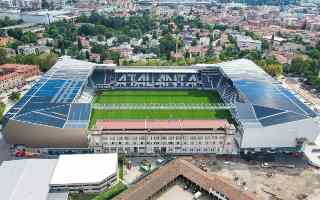Italy: Atalanta Bergamo stadium that overcame Italian bureaucracy
source: StadiumDB.com; author: Jakub Ducki
 Atalanta Bergamo's stadium is an integral part of the city's landscape, and its contemporary form is the result of a major redevelopment completed in 2024. What was the process like and what makes the venue special?
Atalanta Bergamo's stadium is an integral part of the city's landscape, and its contemporary form is the result of a major redevelopment completed in 2024. What was the process like and what makes the venue special?
Advertisement
From Mario Bruman's Campo polisportivo to Gewiss Stadium
Atalanta Bergamo's stadium was built in 1928 as Mario Brumana's Campo polisportivo. Initially equipped with an athletics track and two stands, of which the main stand was distinguished by a reinforced concrete canopy that was innovative for the time. It was renamed Stadio Comunale in 1945 and has operated as Stadio Atleti Azzurri d'Italia since 1994. Atalanta's stadium has been upgraded several times, with another redevelopment completed in 2024.
The decision to extensively modernise Gewiss Stadium was made in 2017, when Atalanta bought the facility from the city. The club, under coach Gian Piero Gasperini, was achieving historic success at the time, which increased the need to adapt the stadium to the requirements of European competition. The design by studio De8 Architetti involved removing the Curva Nord and Curva Sud and replacing them with stands located just behind the goals, giving the stadium a rectangular, typical football layout. Historic elements such as the facades of the old stands and the reinforced concrete roof of the grandstand were retained. In addition, an underground car park was created under the south stand. A modernisation worthy of the Stadium of the Year title? Find out about all 23 venues opening in 2024 and vote for your five favourites!
Work began in April 2019. First, the new Curva Nord was built (opened in October 2019), followed by the upgrade of the East Stand (2020). The final stage, the redevelopment of the Curva Sud, was completed in September 2024.
Costs and effects of Gewiss Stadium modernisation
The redevelopment cost more than €100 million. The stadium was given a modern face, accommodating 24,950 spectators. Unique architectural elements from 1928 were retained, while innovative solutions such as longitudinal trusses with floodlights and a premium sector with heating and catering were introduced.
The reconstructed stadium is a harmonious blend of history and modernity. The main stand (Tribuna Centrale) has retained its historic facade and reinforced concrete roof. In the lower section there is a premium sector for approximately 400 people. The east grandstand (Tribuna Rinascimento), renovated in 2020, refers to the historic character of the stadium. The Curva Nord (Curva Pisani) and Curva Sud (Curva Morosini) are modern, higher stands, covered with panels in shades of grey and blue. Underneath the south stand is an underground car park, increasing the functionality of the facility. The completion of the Bergamo stadium in 2024 made the venue one of the nominees for Stadium of the Year. You can find out about all the honoured stadiums in our YouTube video.
Advertisement

 StadiumDB
StadiumDB